Is the Google Ads Quality Score real?
Some say it’s not.
That’s because it’s not a key performance indicator, and it’s not an ad auction input. In the absence of those tangibles, the Google Ads Quality Score (QS) exists as something of a Bermuda Triangle-style mystery.
SPOILER ALERT: It’s real 🤯
Quality Score might not be a KPI or a selectable field, but it is how the Googlebot algorithm works out what ads provide a good user experience.
And that’s why digital marketers are obsessed with improving Quality Score—and rightfully so.
If you can improve your Quality Score, you stand to save (and even make) more money.
We’ll be talking about what the Google Ads Quality Score is, why you should care about it, and when you shouldn’t care (too much) about it. We’ll cover the facts, the myths, the flat-out conspiracies, and the quick fixes that surround this “Holy Grail” of Google Ads.
Let’s get started.
- What is the Google Ads Quality Score?
- Why Quality Score is important
- What are the benefits of a good Quality Score?
- What happens when you have a low Quality Score?
- How to break down Quality Score
- Types of Quality Score
- How to calculate Quality Score
- How ad rank is calculated
- Best practices for better Quality Score
- Google Ads Quality Score: The most important factors
- Common Quality Score myths
- What are some ways to improve Quality Score quickly?
- Why you shouldn’t care (too much) about Quality Score
- Closing thoughts on Google Ads Quality Score
Get brand new Google ad strategies straight to your inbox every week. 23,739 people already are!
What is the Google Ads Quality Score?
Quality Score judges how relevant your ads, keywords, and landing pages are to a person who sees your ad by assigning a value between 1 (worst) and 10 (best).
Higher Quality Scores lead to lower costs and better ad positions, and lower scores tell you there’s room to improve all those things. And you’re motivated to do so because...
The lower the score, the more you pay per click (opens in a new tab) 😔. The higher the score, the less you pay per click 😎.
Notice that I said click, not conversion.
It sounds almost too simple, right?
Well, it’s not. Sorry.
It’s complex, and there are some emotions involved, too (that I’ll step on a bit later 😏).
For starters, a higher Google Ads Quality Score doesn’t only work to lower cost-per-click (opens in a new tab). It also helps you with a higher ad rank 🥳
In fact, the combination of these three things make up the ad rank equation 👇
- A competitive bid
- High Quality Score
- Relevant ad extensions
With that trio, you have the best chance of ranking in the ✨ highest ad position ✨
Why Quality Score is important
Because it affects your ROI (which is what makes most things in business important):
- Improving your Quality Score lowers your cost-per-click
- Lowering your cost-per-click lowers your cost per conversion
- Lowering your cost per conversion (opens in a new tab) makes you more money.
See where I’m going with this?
What are the benefits of a good Quality Score?
- An improved Quality Score lowers your cost-per-click (CPC), but it might also lower your cost per acquisition (CPA)—which is 1000x more important.
- The higher your Quality Score, the higher your click-through rates (CTR) (usually)
- A higher Quality Score leads to a higher ranking in paid search results
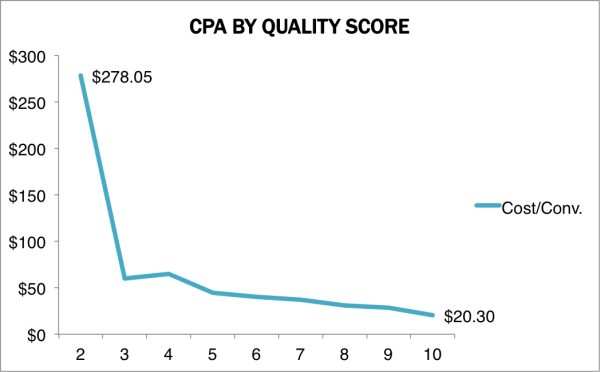
You should focus on improving your Quality Score as you optimize and improve your Google Ads account management (opens in a new tab).
What happens when you have a low Quality Score?
A low QS is bad because it screws with your advertising efforts:
- It lowers click-through rates
- Shows a lack of ad relevance
- Points to improper keywords
- Is embarrassing 😳
How to break down Quality Score
Google Ads (formerly Google AdWords) (opens in a new tab) breaks down Quality Score into three factors:
- Expected CTR: how likely someone will click your ad when it shows
- Ad Relevance: how closely your ad matches the intent behind a searcher’s keyphrase
- Landing Page Experience: how useful your landing page is for people who click your ad and land on your dedicated page
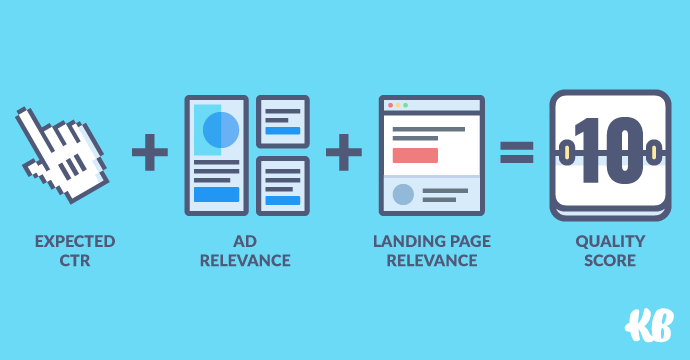
These show what you need to improve. But here’s a broader list of factors that could impact your score directly or indirectly:
- Your ad’s CTR (current and expected)
- Your display URL’s past CTR
- Ad-to-search term relevance
- The overall quality of your landing page
- Your ad’s geographic performance, down to the city level
- The difference in performance per device
To see Quality Score in Google Ads, click on Keywords > Search Keywords and click Columns to customize. Select Quality Score, name the new column set, and save settings.
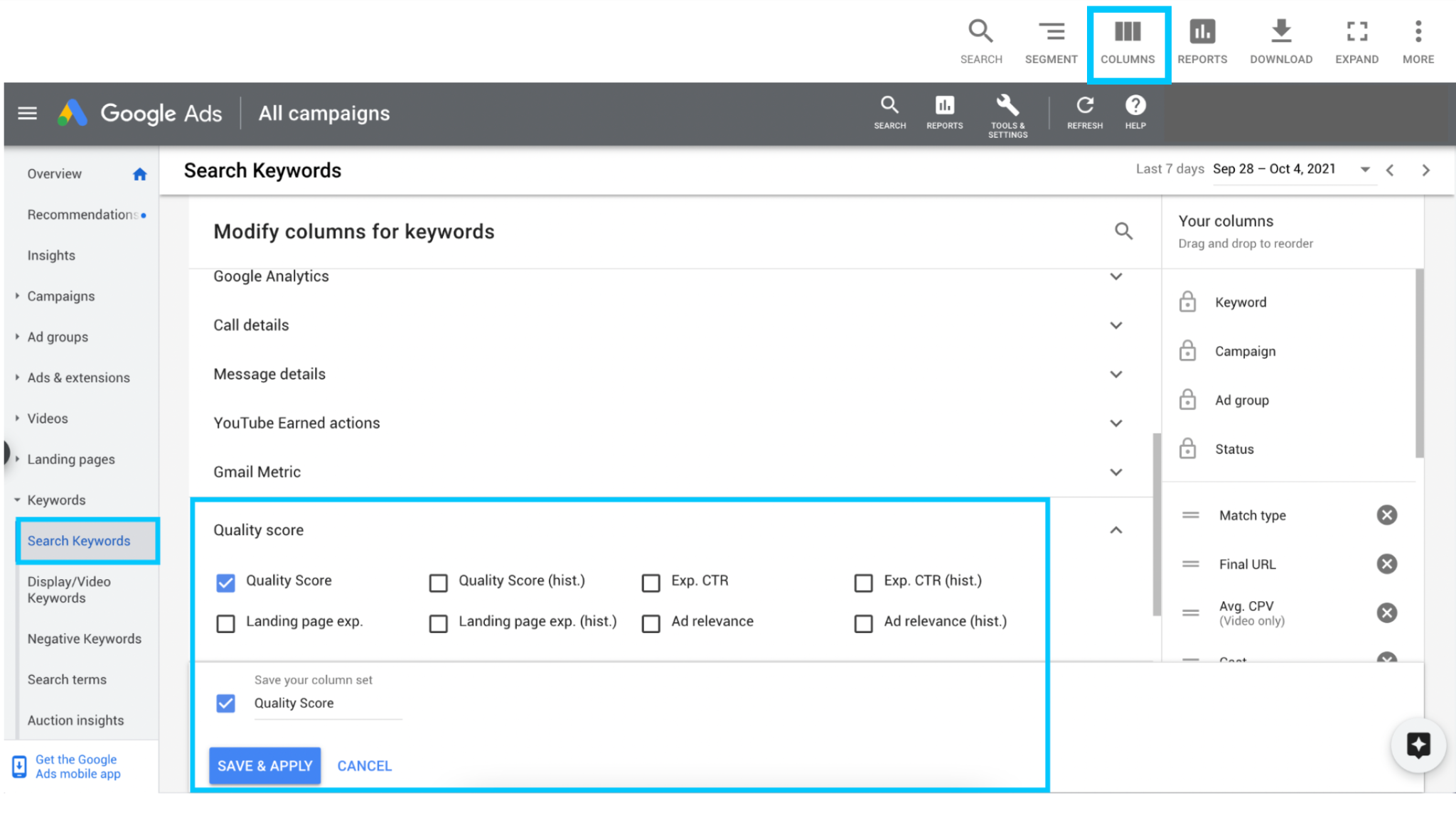
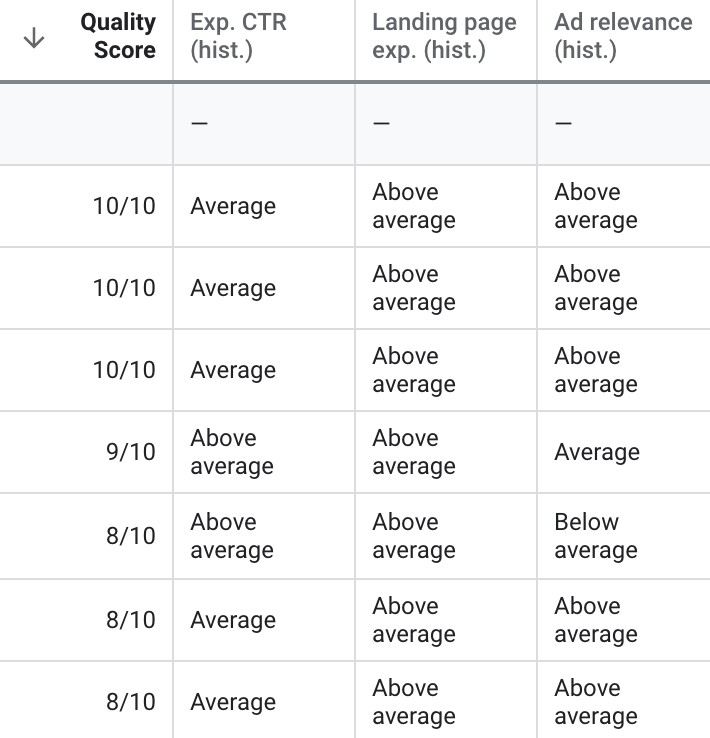
Now, let’s dive into the facts, myths, and conspiracies that surround Quality Scores, as well as what you can do to improve them.
Types of Quality Score
Account
Historical performance of all your account ads and keywords determine your account-level Quality Score.
Ad Group
The Ad Group-level Quality Score looks at the different areas of your ad campaigns that need help.
Please note that Ad group Quality Score is not visible within an account on the ‘Ad Groups’ tab but is an average of the keyword Quality Scores in the specific ad group you’re looking at.
Keyword
This is the Quality Score of the individual keywords you’re targeting. Your keyword-level score is calculated by the performance of search queries that exactly match your keyword.
Ad
The click-through rate of each ad you’re running determines the Ad Quality Score.
Display Network
Historical performance determines the Display Network Quality Score.
Mobile
Quality Score is calculated the same way, regardless of which device platform you choose (computers, iPad, smartphones, etc.). But the system does take the distance between the user and business location into consideration, when available, for mobile ad Quality Score by using device location and location extensions data.
How to calculate Quality Score
Quality score re-calculates every 👏 single 👏 time 👏 your keyword gets an impression. This means that both your Quality Score and ad rank are calculated multiple times a day, depending on the number of impressions your keyword receives.
Remember that each keyword has its own Quality Score, and Google only allows you to see Quality Scores at the keyword level. (I’ll give you a trick to see your ad group, campaign, and account Quality Score in a little bit.)
Many factors go into Quality Score, but here are the main big ones that dominate the increases and decreases in Quality Score:
1. Click-through rate
The CTR of both your ad and keyword. The higher the CTR, the higher your Quality Score, the higher your ad rank.
This is the BIGGEST factor in Quality Score calculations bar none. It’s also the biggest factor in ad rank calculations.
So what do you do?
Test out different ad variations that are extremely specific to the keywords you’re bidding on (opens in a new tab).
And your best option for that?
Single Keyword Ad Groups (SKAGS)
One keyword per ad group makes your ads insanely relevant to the keyword.
Here’s an example: Let’s say you’re a bounce house rental company called “Jumper Castles,” and your keyword is bounce house rental.
The keywords in your one ad group would look like this:
- Broad Match (bounce house)
- Phrase Match (“bounce house rental”)
- Exact Match ([bounce house rental])
And your ads would look something like this:
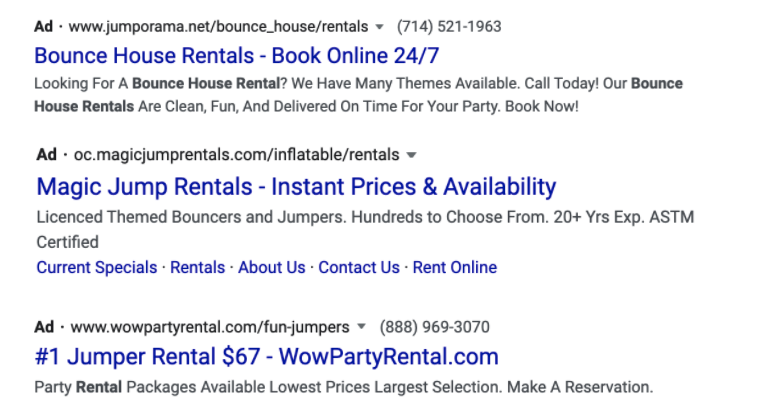
This is often enough to increase your Quality Scores right away, as long as you take the visitor to a page that matches your offer.
If you advertise 20% off, for example, make sure the 20% off is visible on the landing page. Relevance scores high with Google. If Google sees consistent relevance from the keyword to the ad and from the ad to the landing page, you’re rewarded with a higher Quality Score.
Dynamic keyword insertion
Want a quick fix for too many keywords in one ad group? Try the Dynamic Keyword Insertion tool. It adds any of your keywords to your ad copy dynamically (as long as it fits the character limit).
You can read more about it here from Google.
But if you’re wondering if you could instead increase your bids to increase your ad rank and then increase your click-through rate, which in turn might increase your Quality Score, the answer is sure.
But is that sustainable?
Not really, since you’ll be paying for higher cost-per-clicks.
But also, that’s a lazy way of doing things.
2. Historical click-through rate (CTR)
Whether it’s fair or not, Google takes input from your competitors’ bids on the same keywords to determine the Quality Score you receive. It looks at the history of that keyword from other accounts and the general history of that keyword overall.
If your competitors’ CTR has a stronger history than yours, you have work to do.
3. Relevance
Both Quality Score and ad rank are calculated according to relevancy. As mentioned in #1, relevance plays a huge role in how you’re positioned and how much you pay per click.
Therefore, it wouldn’t make sense for you, the person looking for you, or Google, if your one ad group is filled with these keywords like this:
- bounce house rental
- bounce house
- bounce house for sale
- bounce houses for rent
- bounce house buddies
- bounce house blower
- bounce house birthday party
- bounce house business
- bounce house company
- bounce house buy
- bounce house business plan
- bounce house birthday
You can’t possibly know that every ad impression is bang on when you set your ad group up this way.
Make sure your keywords are in their own ad groups with their own ads. Then take it one step further by making the landing page relevant (opens in a new tab) to the keyword and the ad.
4. Account history
In my experience, account history is not a HUGE factor in Quality Score. It may help with minor changes, but if you have a new account, simply follow #1 & #2.
If you’re trying to improve a 10-year-old account suffering from Quality Score neglect, however, it might be difficult to dig your way out.
Google recommends that you don’t create a new account if that is the case, and I agree with them on that point. Your long-term history will help you later once you start making the right changes.
5. Landing page quality
There are three factors Google uses when grading a landing page:
- Relevant, useful, original content
- Transparency and trustworthiness
- Ease of navigation
Let’s talk about that last one, ease of navigation.
Navigation isn't easy if you send a PPC visitor (opens in a new tab) to your homepage. Ads are made with a single purpose, and they deserve a corresponding landing page that elaborates on what the ad promised. Sending ad clickers through to somewhere that doesn’t match the ad’s intent is a navigation fail.
Don’t make users search for information.
Take the visitor directly to the product or service your ad mentions, and make sure that the copy in the ad matches the messaging on the landing page (opens in a new tab).
If there’s a mismatch, your Quality Score craps out, and your ad rank suffers. And, since ad rank is how visible you are, you can’t afford that ad-to-landing-page mismatch. Promise something with the ad and deliver on that promise on the ad’s landing page.
How ad rank is calculated
Ad rank is easier to understand than Quality Score because it doesn’t have as many factors feeding into it. Where your ad ranks depends on only two things: Quality Score and your max bid.
That’s it.
SEOServicesGroup published an interesting formula to determine what your bid and Quality Score should be to rank in your desired position.
Keep in mind that the Google Ads landscape is dynamic, and a formula like this doesn’t guarantee any position. Bid modifiers and strategies from enhanced PPC campaigns must be considered as well.
Best practices for better Quality Score
You know your Quality Score and you want to improve it—hell yes, you do. Okay, then. Here are four ways to do that.
Improve click-through rate
- Choose relevant keywords (goes unsaid)
- Bid enough, especially at the start, so that Google gets some solid data to show you how good your ads really are
- Match type doesn’t matter for QS, but use it to target the right search terms (for better CTR)
- Negative keywords (opens in a new tab) don’t matter for QS—but they’re beneficial for targeting and cost control, so use them
Improve ad relevance
- Create tight ad groups. You don’t need single keyword ad groups (opens in a new tab), but they improve ad relevance. When an ad group has more than 20 keywords, split it up a bit more
- use the keyword in the ad
Improve landing pages
- If you win that click, don’t make the user search (opens in a new tab). That’s why they came to Google in the first place. Target the most relevant page on your site, or direct to your landing page. Sometimes that’s a product page, but it could also be a category page. It’s usually not the homepage though
- Monitor bounce rates and time on site as these factors tell Google whether or not your pages impressed the visitor enough for them to hang around.
This case study shows a 44% increase in ROAS in part thanks to landing page optimization.
Improve structure
- Get rid of low Quality Score keywords, either ones with lots of impressions or the long-tail ones because that adds up to a large portion of your account’s overall traffic. They hurt your account level QS. But don’t get rid of them if they drive conversions and make you money
- Feel free to move things around. Google stores the history, so you can always revert
- Pause or use ad scheduling. No new data = no change to Quality Score
- How you name your campaigns or ad groups doesn’t affect Quality Score (if you wondered)
Google Ads Quality Score: The most important factors
Correlation and causation aren’t the same. It’s a good thing, then, that the Quality Score facts below relate to causation. I’ve grouped them by impact level: high, medium, and low.
Click-through rate (CTR) impact: High
Click-through rate (CTR) is the biggest part of a Quality Score. Chief Economist at Google, Hal Varian, said that it’s as much as 60%.
If you can improve your CTR (clicks divided by impressions), Google most likely rewards you with a higher Quality Score. But CTRs are subjective; they’re relative to
- each keyword
- the history of that keyword
- the current competition levels
A keyword with a 2% CTR might have an 8/10 Quality Score, while a keyword with a 10% CTR has a 4/10 Quality Score.
Keyword to ad ratio impact: High
This is one of the newer facts on the block that I’m claiming. Not only with our clients, but also from the 250+ comments this idea got when I wrote about it a few years back.
The more keywords you have in an ad group, the more likely you’ll dilute the message between the keyword and ad.
This leads to lower click-through-rates and, you guessed it, lower Quality Scores 😭
Analyzing ad group-level QS helps to restructure ad groups with low Quality Score keywords. The history of calculating Quality Score will remain even if visible history is erased. It may be better to pause keywords than to delete, so that Google doesn’t see the addition of the keyword later as a duplicate.
Ads running in each ad group will have varying CTRs. Use Dynamic Keyword Insertion to resolve this issue. It just happens to be one of KlientBoost’s Google Ads copy hacks (opens in a new tab).
Search term to keyword ratio impact: High
Have you ever seen an iceberg in real life? Not the lettuce, an actual frozen, towering iceberg?
I haven’t either, but I’ve seen the equivalent in countless Google Ads accounts.

Depending on the keyword match types (opens in a new tab) you use (mostly phrase match and broad match), you’ll find that what you’re bidding on (keyword on the surface) is far from what you’re actually paying for (search terms below the surface).
Since the discrepancies vary among specific keywords and certain match types, you should know that your click-through rates could be bleeding from this Iceberg Effect.
Once you tighten up the ratio, you’ll find more often than not that your click-through rates will improve as well.
Quick bounces impact: Low
I spoke with Brad Geddes over at CertifiedKnowledge.org, and he dropped this nugget that not a lot of people think about:
Quick Bounces: How often someone goes to your site and quickly leaves and reloads the search results. These are low-quality visits that go to the landing page [experience] portion of Quality Score.”
In a post for our blog, Frederick Vallaeys of Optmyzr.com (and a former Google employee) said:
My personal recommendation is to also keep a close eye on bounce rates and time on site, two metrics you can see in Google Ads when you’re linked to Analytics. A high bounce rate or very short time on site both provide a great way for you to find keywords that are not relevant in the minds of users.
Keep this in mind when diagnosing why some of your keywords have low Quality Scores.
Think exit popups (opens in a new tab) will improve time on site? Maybe. But the root problem might be that there isn’t much to keep people on the site longer.
And even if they do stay, they’re a temporary band-aid covering a broken landing page and/or website.
Landing page experience impact: High
This one is a little mysterious but true.
Over the last couple of years, the landing page experience has become a bigger and bigger factor for Quality Score as more systems automate and human eyes judge whether or not your landing page experience is good or not.
Since much of landing page design (opens in a new tab) is directly related to user experience, this portion of Quality Score is highly subjective.
The biggest things that you need to care about for improving this portion of your Quality Score are:
- Is your content original and unique to your site/landing page (i.e., you didn’t copy it from somewhere else)?
- Do you have a big enough vault of information to be considered trustworthy? Do you have an About Us section, business address, phone number, and social media (opens in a new tab) profile links? Depth of knowledge is scrutinized when advertisers try to promote sites within YMYL (your money, your life) industries that are kept under a close eye (medical, health, IT support, etc.)
- Do you make it easy to navigate to find information and to convert?
- Does your landing page allow the Google bot to crawl your text easily?
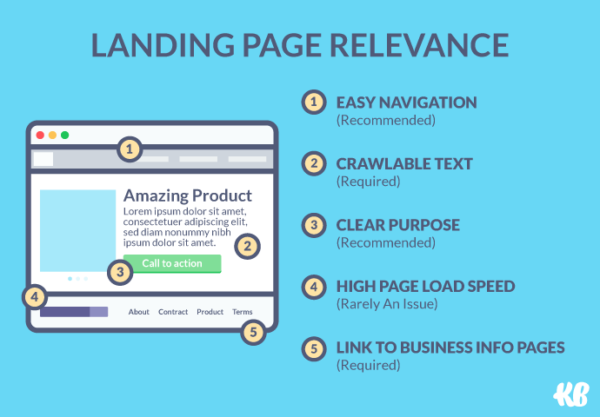
Read more about landing page user experience (UX) and how it affects QS on Google’s official page.
Landing page load time impact: Low
Navigation is part of the landing page experience, and so is the time it takes to load your landing page.
Google wants your page to load in half a second or faster (the time it takes you to blink). Slower than that may hurt your Quality Scores. Half the pages on the internet take around 3 seconds to load (below average in Google’s eyes). Only 6% hit Google’s threshold (although eCommerce sites get a 2-second grace).
The kicker is that load times vary greatly depending on where in the world your ad is shown.
To see how fast your Final URLs are, use Google’s PageSpeed Insights. And here are some ways to shorten your load time.
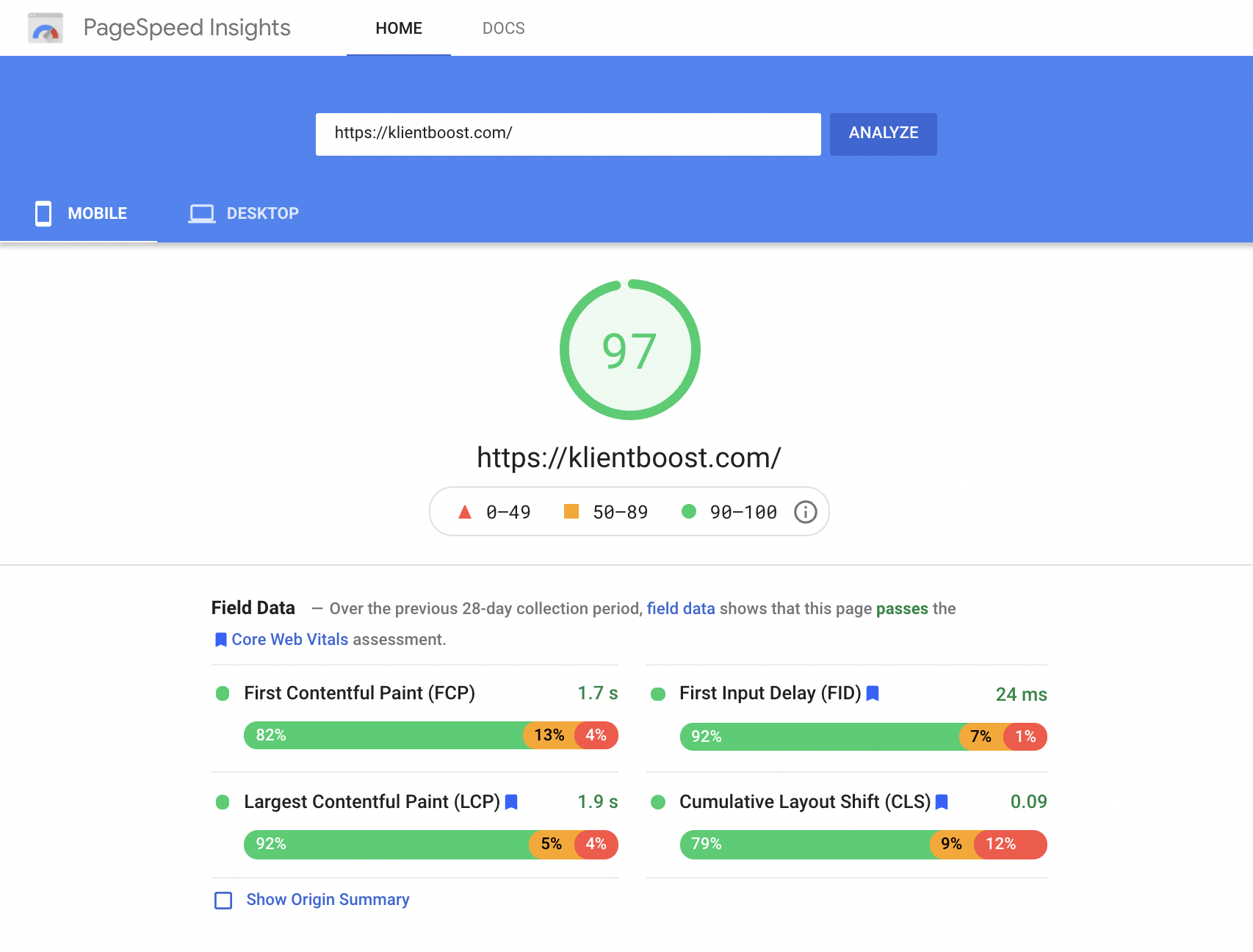
Long-Tail keyword usage impact: Low
The more short-tail keywords you use (the big, broad terms), the lower the odds of a high click-through rate (CTRs). And low CTRs mean low Quality Scores.
Let’s say you’re bidding on the short-tail keyword “desk.”
You’d think the search intent would be strong since people who enter “desk” as a search term are looking to buy a desk. But what if the search term report reveals something different?
Remember the Iceberg Effect?
- desk calendar
- desktop
- desk chairs
- desk lamp
- front desk
- desk fan
As you can see, the more words you have per keyword, the better you get at narrowing down exactly what people are looking for; “desk” isn’t specific.
But don’t just add them to your ad group. Make sure your ad copy and landing page match too.
Match types don’t matter impact: Low
Did you know that your Quality Score doesn’t reflect the keyword you bid on?
The Quality Score you see at your keyword level is based on the search term that exactly matches your keyword. Because of that, your keyword match types don’t affect Quality Score.
Did you know that people used to sell old and empty Google Ads accounts because people thought having an AdWords account from 2002 was a sure way to beat everyone else?
Kinda crazy. The age of a Google Ads account doesn’t affect Quality Score, but how long your account has performed at a high level does.
High-performance account momentum positively impacts Quality Scores (and Google logs momentum compared to your competitors).
And no, erasing poor-performing keywords doesn’t remove your Quality Score history.
Display URL’s past CTR impact: Low
Not to be confused with your root domain, like yoursite.com, your display URL (yoursite.com/this-is-it) is an official component of Quality Score as revealed by Google.
This means that your root domain, and any other display URL you have in your account, all have their own historical impression and click performance log.
Having a specific display URL DOES NOT automatically improve your Quality Score, but it could easily help increase your click-through rate and, therefore, your Quality Score.
Device performance impact: Low
Your Quality Score goes up or down depending on how well your ads perform on mobile, desktop, and tablets.
Performance also differs based on the type of mobile device (Samsung vs. iPhone) and operating system (Android vs. iOS).
This fact was confirmed by Frederick Vallaeys in the post we mentioned earlier, in which he states that Quality Scores on different devices do not affect each other.
Keyword History Impact: High
Suppose you’re brand new and have no advertising history. In that case, Google uses the historical performance of the keywords you’re bidding on (from outside your account) as the base marker, so it’s up to you to exceed that performance by improving your click-through rates.
When you launch brand new keywords in your Google Ads account, Google considers the keyword history outside of your account and looks into your historical CTR for the account and how it’s been performing (hopefully above average).
That said, when it comes to keyword-level Quality Score, historical performance is a more significant factor initially, but once you’ve accumulated enough impressions and performance data, you can rely on that.
How do you boost impressions? Like this:
- Add more broad match keywords, so there’s a less restrictive pool for which you’re showing ads.
- Add more broad themes, to begin with, to assist with adding in more broad match keywords.
- Examine Impression Share data, the percentage of times an ad shows out of total impressions available.
Expected click-through rate impact: Low
In addition to keyword history and account history CTR, Google also uses “expected click-through-rate” to grade QS.
As Craig Danuloff writes on Search Engine Land:
Google uses factors to provide clues about the potential performance of a keyword that hasn’t yet proven itself.
But, once your account and keywords have enough history, that will replace the expected click-through rate, and you’ll hopefully have two thumbs up from Google.
Geographic performance impact: Low
Like your devices have individual Quality Score metrics, so do the cities, counties, countries, and regions you’re targeting.
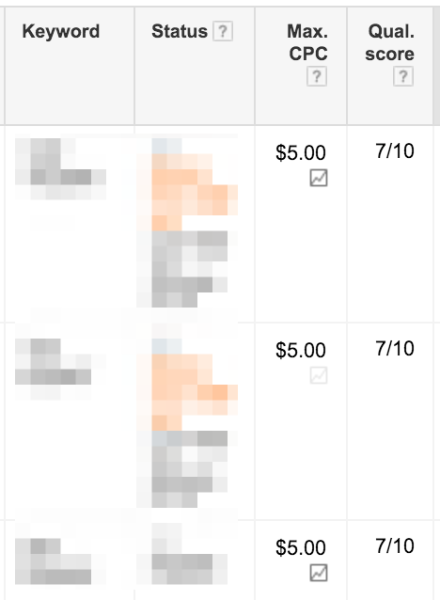
And although you can’t see the geographic breakdown within your Google Ads account, you can run your own test by splitting up campaigns by geography and tracking the difference in performance.
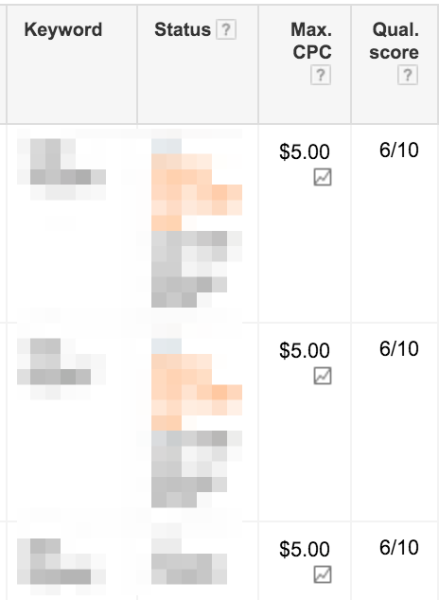
“What the F’, North Carolina?!” – me
Now, keep in mind that this kind of experiment isn’t pure, and there might be more competitors or higher bid prices in one geography versus another.
Still, it’s clear that ad performance and CTRs vary greatly by geography and, therefore, affect Quality Score as well.
Time of day/day of week performance impact: Low
Have you ever tried advertising late at night while all your competitors are sleeping?
It’s a smart idea, but how did it work out? Did your CTR increase or decrease? As an official part of Google’s Quality Score docs, time of day and day of the week impact CTR, which helps or hurts your Quality Scores.
If you’re running campaigns 24/7, try splitting up a few campaigns with different time ranges to see if your Quality Scores and cost-per-clicks are affected.
Those are the true factors that affect Quality Score. But what about all the blown-up myths swirling around the internet about QS?
Common Quality Score myths
If you’ve ever been part of a hot topic debate like the Bermuda Triangle (Amelia, are you out there?), the moon landing (what happened in those 2 minutes of radio silence?), or Quality Scores, then you know there’s a lot of information out there that isn’t true.
Let’s bust some of the Quality Score myths.
Ad Extensions help
Contrary to popular belief, ad extensions (opens in a new tab) don’t directly impact Quality Scores. They’re part of the newer ad rank equation, but again, they have no causation for Quality Scores.
The confusion may have started with the fact that ad extensions increase the real estate space of your ad. More real estate increases your click chances and, therefore, increases your click-through rates and Quality Scores. Ad extensions themselves, however, won’t have a direct effect.
Pausing hurts
Pausing your ad groups, campaigns, or entire Google Ads account has no direct impact on your Quality Scores. While certain campaigns (display and search) may lose momentum when paused, your Quality Score and related data stay intact.
Only one Quality Score
To the visible eye, you’re only able to see keyword-level Quality Scores inside your Google Ads account.
However, there’s also an overall account Quality Score that you can uncover with hidden Google Ads scripts, like this one from Optmyzr.
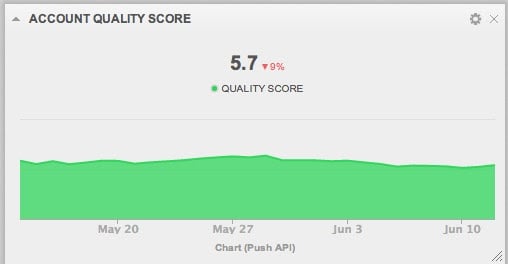
But be careful. Quality Score is not a key performance indicator—cost per conversion and conversion rates are.
Sometimes, you can have mutual Quality Score and conversion goals. But sometimes you can’t.
Higher Quality Scores don’t always equal more money being made.
Display & search competition
Believe it or not, there’s also a hidden Quality Score for display network campaigns.
The downside is you can’t see it.
But that hasn’t stopped people from saying that display performance affects Quality Scores on the search network.
It’s not true. Or, at least, it hasn’t been proven. Just like on the search network, your display performance relies on different metrics depending on your targeting.
Negative keywords
Similar to the assumption that ad extensions affect Quality Scores, adding or removing negative keywords has no direct impact on Quality Score.
But adding negative keywords is a tool you use to improve your click-through rates, which indirectly improves your Quality Score.
Keywords on landing pages
As Brad Geddes himself has said (and our own experience supports this), keyword stuffing or using more keyword insertions on landing pages doesn’t improve Quality Scores.
Covering up dead bodies
If you delete low-quality keywords, does that improve overall keyword level Quality Scores? Not at all 😜
Since Quality Score is mainly based on historical performance, the only thing that deleting low-quality keywords does is make it easier to manage your account.
Pausing them does the same thing.
You might have some keywords with low Quality Scores and decent cost per conversion. If that’s the case, don’t sacrifice an important KPI for a mediocre metric.
Bidding high to maintain
You’d think that a higher average position (opens in a new tab) could lead to a higher Quality Score.
But artificially bidding to a higher level in the hopes of capturing and then maintaining a higher Quality Score after you lower your bids back down doesn’t do much.
In the ad auction, you’re always competing on CTR against competitors in the same ad position. This means that you can easily lower your bids without the fear of lowering your Quality Score if your ad text stays the same.
The following formulas depict how bid along with Quality Score impacts Ad Rank:
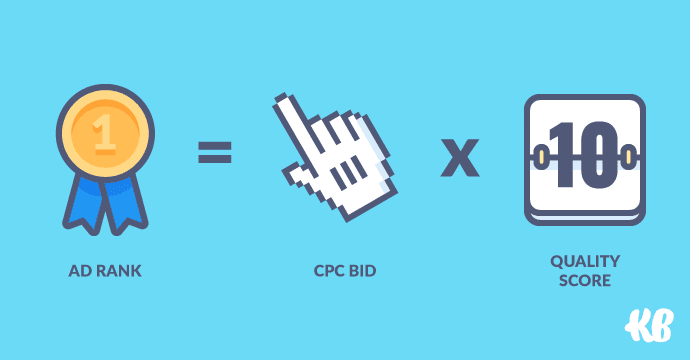
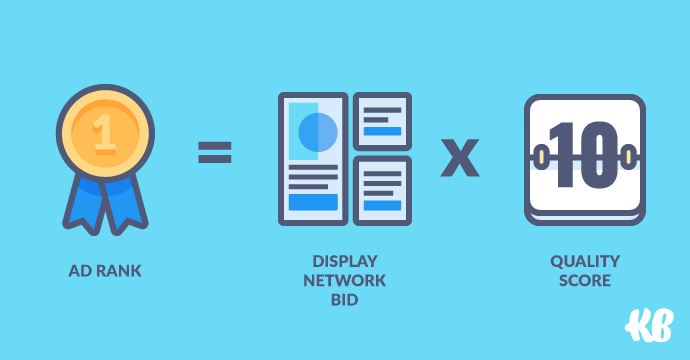
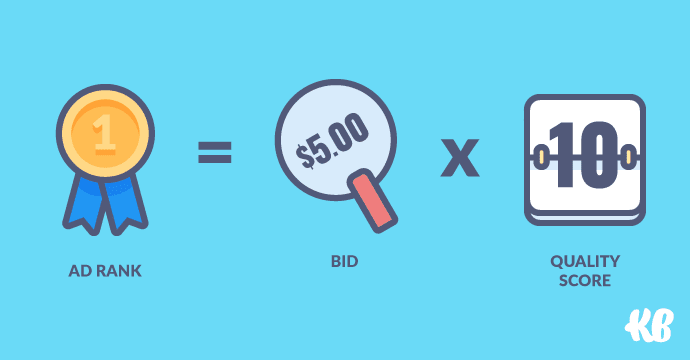
Account structure doesn’t matter
😆 It so matters!
But again, this isn’t a direct impact on Quality Score, and it’s more the factors that make up Quality Score, such as click-through rate.
Like the Iceberg Effect, the more you care and focus on making your keyword-to-ad and search term-to-keyword ratio 1:1, the better your chances are of getting a higher CTR and, therefore, a higher Quality Score.
Conversion rates
Conversions are subjective and can be made up anywhere (you could plant paste a conversion code on your homepage to get a 100% conversion rate). Google doesn’t care or take that into account when determining your Quality Score.
If it was a factor, there would be so much Quality Score manipulation that it would be ridiculous 🥸
Keyword insertion always works
The keyword insertion feature automatically inserts your keyword into the ad copy to save time and effort. (If you aren’t familiar with Keyword Insertion, you can read more about it here.
Because of this “relevancy bump,” many people think it directly impacts their Quality Score, without considering that it could help improve the CTR first and then the Quality Score after.
Further, it’s also important to remember that Keyword Insertion adds in the keyword, not the search term. So if your search term-to-keyword ratio is around 1:30, then your CTR improvement chances are lower than if that ratio was closer to 1:10.
What are some ways to improve Quality Score quickly?
Now that you know fact from fiction, let’s dive into the two biggest ways you can systematically improve your click-through rate and, therefore, your Quality Scores.
Single Keyword Ad Groups (SKAGs)
The article that gave birth to the Iceberg Effect was one I wrote for the Unbounce blog: You’re Doing AdWords Wrong (Here’s How to Make It Right).
(It then turned into 5+ upgrades to our Single Keyword Ad Groups (opens in a new tab) blog post).
Aside from professing my love for Nutella, I show why and how you create single keyword ad groups to improve your CTR.
Here’s the gist of the article:
- Each ad group can only have one keyword in it
- The keyword should have the three match types: exact, phrase, and broad match modifier
- The ads should be specific to that one keyword
When that happens, you improve both the ratios we talked about earlier and your Quality Scores.
Geographic specificity
Just like Single Keyword Ad Groups make sense, so do geographic-specific campaigns with city/county wording in ads and landing pages.
Granulating geographic areas show their individual Quality Scores. It also helps you manage your ad and landing page message. This improves your CTRs, Quality Scores, and your conversion rates, too.
Timeliness
Quality Score improves with the time of year or holidays when you mention it in your ads.
You don’t have to run a specific sale, but showcasing an ad with a time-based aspect tells the prospective Google searcher that your ad is more relevant than the other ads.
An example from KlientBoost could be us mentioning how many marketing plan requests we got last month.
Why you shouldn’t care (too much) about Quality Score
After all that, let me be the first to say that Quality Scores are EXTREMELY overrated 😏
People obsess over Quality Scores as the “last PPC frontier” that they’ve yet to conquer in their account.
Some of your keywords (like bidding on competitor names) will always have low Quality Scores, but their cost per lead and conversion rates are great.
Quality Score is a metric like any other. It’s not something that genuinely affects the money you’re making.

If you know the value of conversion rate optimization (CRO), then instead of obsessing over Quality Scores, obsess over improving your conversion rates, sales funnel, tracking, lifetime values, etc.
Closing thoughts on Google Ads Quality Score
Quality Score somehow grew into a mysterious question mark in league with Area 51, the Knights Templar, and Loch Ness.
But it’s way more boring than that. It’s simply a metric that leads to frown lines and grey hair.
I hope that after reading this post, you’re fully aware that there’s only so much you can do to improve it (if you’re interested in exploring the topic even further, read iSpionage’s take on QS here).
If you want even more information about Google Ads Quality Score, SEMrush created a video on Cracking Google’s Black box.
Think of it as a measuring stick for your competition. If you’re at a 5/10 or lower, your CTR is crap compared to the rest. Put on your big boy pants and fix it.
And if I missed something….. did I?
